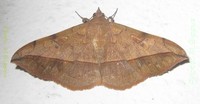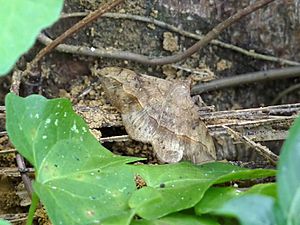Owl moth facts for kids
Quick facts for kids Owl moth |
|
|---|---|
 |
|
| Scientific classification | |
| Kingdom: | |
| Phylum: | |
| Class: | |
| Order: | |
| Family: | |
| Genus: |
Anticarsia
|
| Species: |
A. irrorata
|
| Binomial name | |
| Anticarsia irrorata (Fabricius, 1781)
|
|
| Synonyms | |
|
|
The owl moth (scientific name: Anticarsia irrorata) is a type of moth. It belongs to the Noctuidae family, which includes many different kinds of moths. You can find the owl moth in warm, tropical parts of the Old World. This means places like Africa, Asia, and Australia.
What Does the Owl Moth Look Like?
The owl moth is a medium-sized moth. Its wings can spread out about 40 to 46 millimeters wide. That's about the size of a large coin!
The moth is usually light brownish. It has darker areas towards the outer edges of its wings. Each front wing has a diagonal line and a row of black dots. The back wings have similar patterns. Underneath, the wings have lighter, brownish dots and a white spot.
The Caterpillar Stage
The young owl moth, called a larva or caterpillar, is light green. It has a dark green line down its back with a yellowish center. There are also wider, spotted lines on its sides.
The caterpillar moves in a looping way, like an inchworm. It has special breathing holes called spiracles. These are white with black edges.
What Do Owl Moths Eat?
The owl moth and its caterpillars like to eat many different plants. They often feed on plants from the legume family. This family includes plants like beans and peas.
Some common food plants are:
- Cajanus (like pigeon pea)
- Cicer (like chickpeas)
- Cyamopsis (like cluster bean)
- Glycine (like soybeans)
- Lablab (like hyacinth bean)
- Mucuna (like velvet bean)
- Phaseolus (like common beans)
- Vigna (like cowpeas)
They also eat other plants. These include the melon genus Cucumis. They can also be found on grasses. Some grasses they eat are Andropogon, Oryza (rice), Paspalum, and Saccharum (sugarcane).


